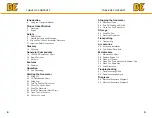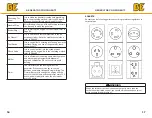
10
11
DANGER
Improper grounding can result in a risk of electrocu-
tion. Check with a qualified electrician for your local
requirements if you are in doubt as to whether the unit
is properly grounded.
This generator is equipped with a grounding terminal for added
protection. Using the ground path from the generator to an
external ground source as instructed in the section labeled “Grounding
Instructions” in the Preparation section of this manual can be
necessary. Please consult a qualified electrician for local regulations.
The generator is a potential source of electrical shock if not kept dry.
Keep the generator dry and do not use in rain or wet conditions. To
protect from moisture, operate it on a dry surface under an open,
canopy-like structure. Dry your hands if wet before touching the
generator.
Plug appliances directly into the generator. Or, use a heavy duty,
outdoor-rated extension cord that is rated (in watts or amps) at least
equal to the sum of the connected appliance loads. Check that the
entire cord is free of cuts or tears and that the plug has all three
prongs,especially a grounding pin.
NEVER try to power the house wiring by plugging the generator into
a wall outlet, a practice known as “back feeding”. This is an extremely
dangerous practice that presents an electrocution risk to utility workers
and neighbors served by the same utility transformer. It also bypasses
some of the built-in household circuit protection devices.
If you must connect the generator to the house wiring to power
appliances, have a qualified electrician install the appropriate
equipment in accordance with local electrical codes.
This product has been designed with internal grounding or floating
bonded neutral. If it should malfunction or breakdown, grounding pro-
vides a path of least resistance for electric current to reduce the risk of
electric shock.
• Do not enclose the generator or cover it. The generator may become
overheated if it is enclosed. If generator has been covered to protect if
from the weather during non use, be sure to remove it and keep it well
away from the area during generator use.
• Operate the generator on a level surface. It is not necessary to prepare
a special foundation for the generator. However, the generator will
vibrate on an irregular surface, so choose a level place.
If the generator is tilted or moved during operation, fuel may spill and/or
the generator may tip over, causing a hazardous situation.
Proper lubrication cannot be expected if the generator is operated on a
steep incline or slope. In such a case, piston seizure may occur even if
the oil is above the upper level.
• Pay attention to the wiring or extension cords from the generator to the
connected device. If the wire is under the generator or in contact with
vibrating part, it may break and possibly cause a fire, generator burnout,
or electric shock hazard. Replace damaged or worn cords immediately.
• Do not operate in rain, in wet or damp conditions, or with wet hands.
The operator may suffer severe electric shock if the generator is wet due
to rain or snow. If wet, wipe and dry it well before starting. Do not pour
water directly over the generator, nor wash it with water.
• Be extremely careful that all necessary electrical grounding procedures
are followed during each and every use. Failure to do so can be fatal.
• DO NOT smoke while charging a battery. The battery emits flammable
hydrogen gas, which can explode if exposed to electric arcing or open
flame. Keep the area well ventilated and keep open flames / sparks away
when charging a battery.
• The engine becomes extremely hot during and for some time after
operation. Keep combustible materials well away from generator area.
Be very careful not to touch any parts of the hot engine especially the
muffler area or serious burns may result.
IMPORTANT SAFETY INSTRUCTIONS
WARNING
To reduce the risk of injury, read this operator’s manual
completely before using.
When using this product, the following basic
precautions should always be followed.
SAFETY
SAFETY





































